Sold Ceramics
Sold Blue and White Kangxi Period 1662-1722
Dishes
Page 3
Around 1680, Emperor Kangxi (1662–1722) established his authority over all parts of China after a long period of civil strife. The porcelain factories in Jingdezhen that were demolished in 1675 resumed production and within a few years exports were booming. Chinese junks sailed to Batavia, bringing their porcelain to the market. From there, it was shipped to the Netherlands in VOC (Dutch East India Company, 1602–1799) vessels. However, private individuals bypassed the Company and also imported huge quantities of porcelain to Holland. In Europe, a change in dining habits and the introduction of tea and coffee created new demands. New varieties of Chinese export porcelain were produced, including all kinds of Western shapes. Porcelain, sometimes in miniature, was frequently used to decorate house interiors in Europe.
Much porcelain of this period is decorated in a clear, transparent underglaze blue. Popular decorations included the Buddhist lotus motif, a pheasant with long tail feathers on a rock amidst flowers, and the ‘Long Eliza’ with the 'Dancing Fool', the Dutch name for a Chinese lady and a small boy depicted in a garden.
Kangxi porcelain is very well made, with a thin body, a balanced shape and a smooth glaze without impurities. Cobalt blue oxide was subtly applied in varying degrees of saturation, suggesting depth and volume. The colour ranges from a silvery to a deep dark blue; in the best pieces the details and the craftsmanship are amazing. However, due to stricter controls by officials, the freedom and easy way of painting that was so characteristic of the preceding Transitional period now gave way to a more formal style with an emphasis on symmetry and centralism.

Sold Ceramics - Sold Blue and White Kangxi Period 1660-1722 - Dishes - Page 3
Object 2011340
Dish
China
1700-1710
Height 65 mm (2.56 inch), diameter of rim 338 mm (13.31 inch), diameter of footring 195 mm (7.68 inch), weight 1.441 grams (50.83 ounce (oz.))
Dish of moulded form on footring with straight sides and a foliated rim. Decorated in underglaze blue with a basket containing flowering plants and hanging ribbons in a double concentric band. On the sides twelve moulded petal-shaped panels, each enclosing a flowering plant. Round the rim a trellis and scale pattern border. On the reverse three sprays of flowering branches. Marked on the base with the symbol mark: Lotus, symbol of purity and one of the eight Buddhist Emblems, in a double circle, underglaze blue.
For an identically shaped, sized and decorated dish, please see:
Condition: A hairline and four glaze rough spots to the rim. A chip to the rim and the inner footring.
References:
Jörg & Van Campen 1997, cat. 86
Sjostrand & Lok Lok 2007, pp. 271-278
Price: Sold.
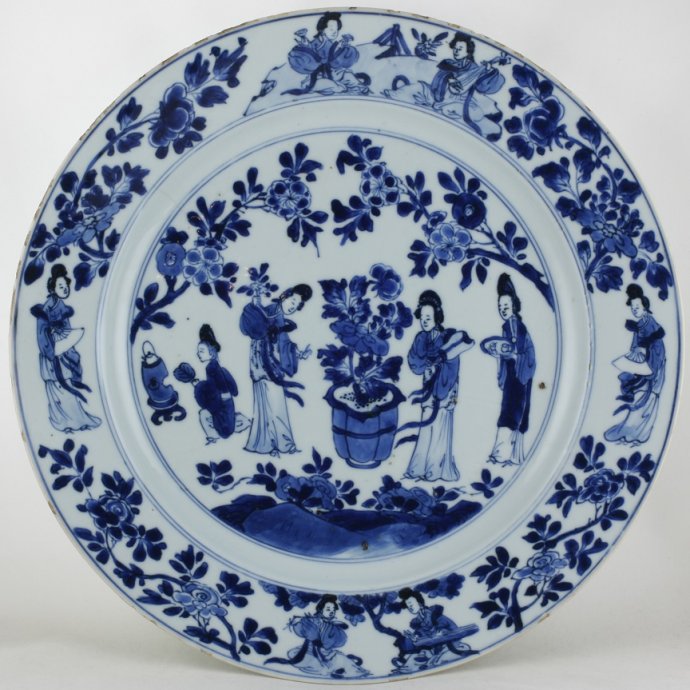
Sold Ceramics - Sold Blue and White Kangxi Period 1660-1722 - Dishes - Page 3
Object 2012441
Dishe
China
1690-1700
Height 42 mm (1.65 inch), diameter of rim 318 mm (12.52 inch), diameter of footring 175 mm (6.89 inch), weight 1,019 grams (35.94 ounce (oz.))
Dish on footring, spreading flat rim. Decorated in underglaze blue with a garden scene landscape with blossoming cherry trees, two roses on a small mound in the foreground. In the centre a pot with a peony. On the right a woman with a fan, another woman carrying a tray. On the left a woman with a flower spray and a servant kneeling in front of a stove. On the rim two groups of three female musicians and two pairs of women. In between the groups roses alternating with peonies. The reverse with three rose sprays. On the base a six-character Chenghua mark in a double circle.
In his Fine & Curious, Jörg compares two identically decorated dishes one Chinese the other Japanese. He states that the Japanese example was clearly copied from the Chinese Kangxi dish, but it is noteworthy that it is better painted with more attention to detail (compare the flowers) than its Chinese counterpart. (Jörg 2003/1, p.138)
Sold object 2012442, an identically, shaped, sized and decorated Japanese dish (this dish is not included in this sale/offer.
For an identically decorated Chinese dish, please see:
- Fine & Curious, Japanese export porcelain in Dutch Collections, (C.J.A. Jörg, Hotei Publishing, Amsterdam, 2003), p.138, cat. 151b.
- Austrumu porcellans un Niderlande. Austrumu un Rietumu mijiedarbiba 17. gadsimta / Oriental Porcelain and the Netherlands. Interaction between East and West in the 17th century, (C.J.A. Jörg, Art Museum Riga Bourse, Riga, 2011), pp.206-207, cat. 70.
For an identically decorated Japanese dish, please see:
- Fine & Curious, Japanese export porcelain in Dutch Collections, (C.J.A. Jörg, Hotei Publishing, Amsterdam, 2003), p.138, cat. 151.
- Austrumu porcellans un Niderlande. Austrumu un Rietumu mijiedarbiba 17. gadsimta / Oriental Porcelain and the Netherlands. Interaction between East and West in the 17th century, (C.J.A. Jörg, Art Museum Riga Bourse, Riga, 2011), pp.206-207, cat. 71.
Condition: A chip, a hairline and various glaze rough spots al to the rim.
Reference:
Price: Sold.
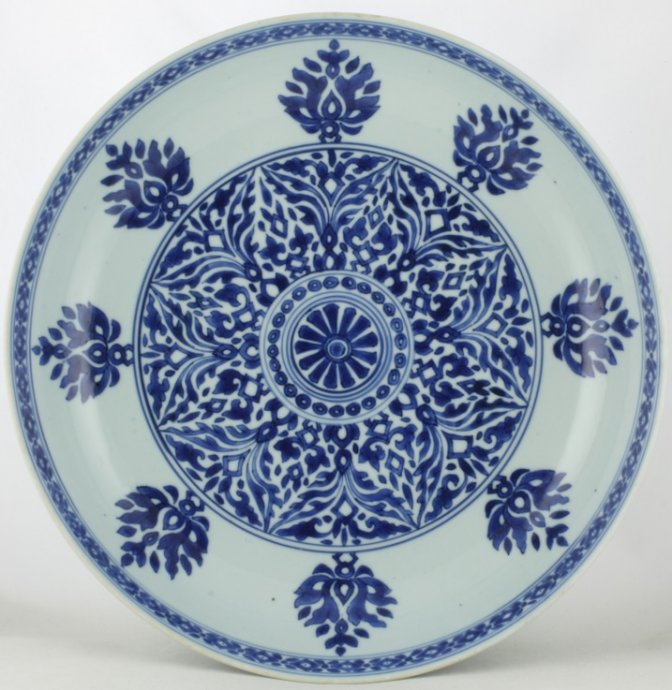
Sold Ceramics - Sold Blue and White Kangxi Period 1660-1722 - Dishes - Page 3
Object 2011894
Dish
China
c.1700
Height 72 mm (2.83 inch), diameter of rim 335 mm (13.19 inch), diameter of footring 172/152 mm (6.77/5.98 inch), weight 1.723 grams (61.09 ounce (oz.))
Dish on a channel footring, with spreading sides. Decorated in underglaze blue. In the centre a roundel with a formal lotus flower framed by a border with circular ornaments and surrounded by dense foliate scrolls. On the sides eight symmetrically arranged pear-shaped palmettes. Around the rim an ornamental border. On the reverse an ornamental and spear-head border. Around the footring a border of pointed and folded lotus leaves.
The decoration on this dish has an Islamic character which is usually connected with porcelain destined for the Indian, Persian or Middle-Eastern markets. The palmettes are drawn from Islamic textile art that are, for instance, familiar from Mamluk, Safavid and Mogul Indian brocades. Palmettes of this kind are also to be seen on Indian 'bidri ware' metal objects adorned with silver inlay. Such pieces have also been collected in Indonesia as well. A good variety is illustrated by Krahl & Ayers in their catalogue of the Topkapi collection, Istanbul. (Jörg & Van Campen 1997, p.137, cat. 145), (Düsseldorf 2015, p.263)
For similarly decorated objects most likely made for the Indian, Persian or Middle-Eastern market, please see:
- Pronken met Oosters porselein, exhibition catalogue Gemeente Museum Arnhem, (S. Hartog, Waanders, Zwolle 1990), p.59, cat. 37.
- Chinese Ceramics in the Collection of the Rijksmuseum Amsterdam. The Ming and Qing Dynasties, (C.J.A. Jörg in collaboration with J. van Campen, Rijksmuseum Amsterdam, London 1997), p.137, cat. 145.
- Famille Verte, Chinese Porcelain in Green Enamels, (C.J.A. Jörg, Schoten, 2011), p.35, cat. 23
- Porzellanschätze der Kangxi-Zeit / Porcelain Treasures of the Kangxi Period, (Exhibition catalogue, Deutsch-Chinesische Verlagsanstalt, Düsseldorf / Beijing 2015), pp.262-263, cat 141.
- 300 Treasures, (F. Suchomel, Academy of Arts, Architecture and Design in Prague, Prague, 2015), p.272, cat. 144.
-
Sold Ceramics - Sold Polychrome wares other since 1722 - Page 3 - Object 2011362.
This dish has a channel footring. It is still not known what its function may have been, but possibly the dish - filled with food or offerings - was meant to be placed on a wooden stand, which would have made it more stable. Dishes with channel footrings first appear in the 1670s and were made until c.1700; they no longer appear in 18th-century assortments. (Jörg 2011/2, p.49)
Condition: An overall shallow rough rim with three (restored) chips (with a connected hairlines) and five single hairlines.
References:
Jörg & Van Campen 1997, cat. 145
Price: Sold.

Sold Ceramics - Sold Blue and White Kangxi Period 1660-1722 - Dishes - Page 3
Object 2011926
Dish
China
c.1700
Height 43 mm (1.69 inch), diameter of rim 220 mm (8.66 inch), diameter of footring 113 mm (4.45 inch), weight 305 grams (10.76 ounce (oz.))
Moulded dish on footring with a straight rim and a lobbed edge. Decorated in underglaze blue with a central peony flower head surrounded by leafy scrolls reserved on an underglaze blue ground. On the sides and rim birds in flight alternating with flower sprays. On the reverse three flower sprays. Marked on the base with a square shop mark in a double circle, underglaze blue.
In China the peony is the king of flowers. Here the white peony may stand for a beautiful and clever girl. (Hartog 1990, p. 147)
For an identically shaped and decorated dish, please see:
Condition: A firing flaw to the inner footring.
Reference:
Price: Sold.
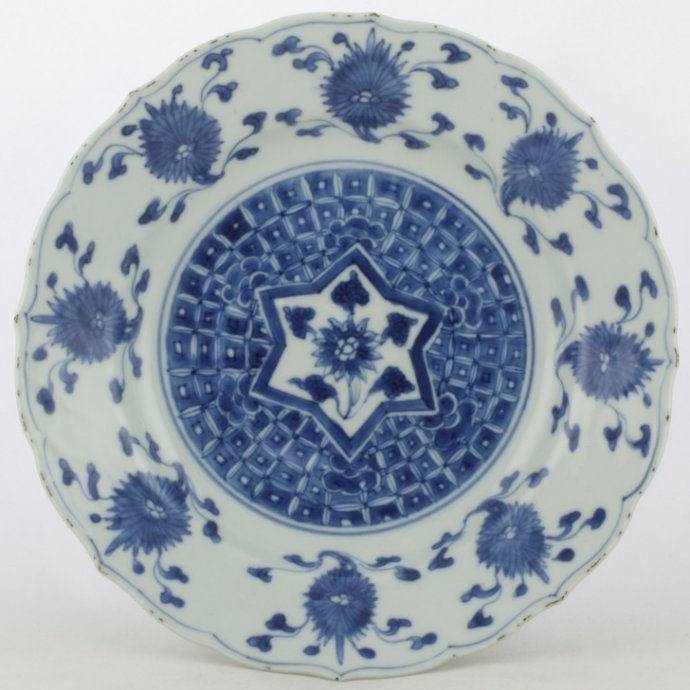
Sold Ceramics - Sold Blue and White Kangxi Period 1660-1722 - Dishes - Page 3
Object 2011861
Dish
China
1700-1720
Height 38 mm (1.50 inch), diameter 221 mm (8.70 inch), diameter of footring 112 mm (4.41 inch), weight 360 grams (12.70 ounce (oz.))
Dish on footring with a flat rim and a scalloped edge. Decorated in underglaze blue. In the centre a star-shaped panel containing a lotus surrounded by four rows of linked cash motifs. On the sides and rim eight lotus flowers and scrolls. On the reverse eight single peonies. (Jörg 2002/2, p.83)
For an identically decorated dish, please see:
- Aziatische Ceramiek en Glas, (D.F. Lunsingh Scheurleer, exhibition catalogue of the J.M. van Diepen Collection, Fraeylemaborg, Slochteren, 1982), p.14, cat. 21.
- Jan Menze van Diepen Stichting. Selectie uit de collectie Oosterse keramiek. (Jan Menze van Diepen Foundation. A Selection from the Collection of Oriental Ceramics), (C.J.A. Jörg, Slochteren, 2002), p.83, cat. 55.
The symmetrical decoration is characteristic of the sometimes rather rigid decorations on the late 17th-century Kangxi porcelain. The often skilfully painted scenes of landscapes and figures of the late transitional porcelain disappeared soon after the Jingdezhen kilns were restored and resumed production c. 1677. The re-implementation of the Imperial prescripts governing objects produced for the court also dictated the style of un regulated production for both the local market and export. The lotus is the Buddhist symbol of purity and love. It is impartial and therefore a highly appropriate motif having no references to earlier political situations. (Jörg 2002/2, p.83)
Condition: Various popped bubbles of glaze and a single frit to the rim, a rough footring.
References:
Lunsingh Scheurleer 1982/2, cat. 14
Price: Sold.

Sold Ceramics - Sold Blue and White Kangxi Period 1660-1722 - Dishes - Page 3
Object 2011642
Dish
China
1700-1715
Height 43 mm (1.69 inch), diameter of rim 333 mm (13.11 inch), diameter of footring 173 mm (6.81 inch), weight 985 grams (34.75 ounce (oz.))
Dish on footring with a wide spreading flat rim. The edge in underglaze brown (jia mangkou). Decorated in underglaze blue with a flowering lotus in a scalloped medallion in the centre surrounded by two clusters of flowering chrysanthemum and peony plants and scrolls. On the rim a continuous flowering peony and chrysanthemum scroll. The reverse is undecorated. On the base, written in degraded black ink: 'J. Kortenoever Secretaris-Thesaurier van de Groot of Oranje Societeit te Zutphen 1929 17 juni 1954' and an old paper label that reads: 'Aangeboden aan J. Kortenoever Secretaris-Thesaurier van de Groot of Oranje Societeit te Zutphen ter gelegenheid van zijn 25-jarig bestuurslidmaatschap. 17 Juni 1929 - 17 juni 1954. (Presented to J. Kortenoever Secretary-Treasurer of the Large or Orange Society in Zutphen on the occasion of his 25-year member of the board membership. 17 June 1929 – 17 June 1954) (Sargent 2012, p.183)
The Groote of Oranje Sociëteit (Large or Orange Society) in Zutphen was founded on 16 April 1763 and is one of the oldest societies in the Netherlands.
Condition: A tiny glaze chip to the reverse rim. Four frits, a chip and a glaze rough spot all to the rim .
Reference:
Price: Sold.

Sold Ceramics - Sold Blue and White Kangxi Period 1660-1722 - Dishes - Page 3
Object 2012411
Dish
China
1700-1720
Height 35 mm (1.65 inch), diameter of rim 210 mm (10.95 inch), diameter of footring 105 mm (5.91 inch), weight 309 grams (10.90 ounce (oz.))
Dish on footring, flat rim with a foliated edge. Decorated in underglaze blue a lowering tree growing in front of a fence with birds in flight surrounded by a zig-zag-lines pattern border. On the sides eight petal-shaped panels, each enclosing two flowering plant outlined by a zig-zag-pattern borders connected at the rim by single looped bow. On the reverse three wide spread flower sprays. Marked on the base with the symbol mark: Ding incense burner, in a double circle, underglaze blue. On the base an old rectangular paper dealers label that reads: 'Fa. A.C. Beeling & Zn Hofleverancier (seller to The Dutch Royal House), Leeuwarden, China periode K'ang-Hsi (1662-1722) antiquiteiten'. (Davison 1994, cat. 1833)
Antiquarian A. C. Beeling & Zn was founded in 1886 by A. C. Beeling, son of Johannes Beeling, a master silversmith who had been trading in silver ever since 1864 (Leeuwarder Courant, 03-09-1973). The current A. C. Beeling is the grandson of the founder of the company. His father expanded the business, which at first mostly dealt with clocks and watches, with silver, furniture, china and more (De Telegraaf, 08-10-1993). A. C. Beeling & Zn received its Royal Warrent of Appointment in 1939 (Leeuwarder Nieuwsblad, 04-08-1939). (source: rkd.nl)
For other objects fitted with the rectangular paper dealers label that reads: 'Fa. A.C. Beeling & Zn Hofleverancier (seller to The Dutch Royal House), Leeuwarden, please see:
Condition: Some tiny glaze rough spots to the edge of the rim and a hairline to the rim.
Reference:
Price: Sold.

Sold Ceramics - Sold Blue and White Kangxi Period 1660-1722 - Dishes - Page 3
Object 2011085
Dish
China
c.1700
Height 27 mm (1.06 inch), diameter of rim 217 mm (8.54 inch), diameter of footring 119 mm (4.69 inch)
Dish on footring with a straight rim. Decorated in underglaze blue and gold with a dragon in a central wide band, On the sides three dragons have been finely incised into the porcelain. Round the rim a foliage scroll pattern border in gold on a underglaze blue ground. Marked on the base with a square shop mark in a double circle, underglaze blue
The incised pattern is barely discernible to the naked eye unless the ware is held up to the light. The incised recesses have been filled with a transparent glaze to create a flat surface. The Chinese call this technique anhua (hidden decoration). (Emden 2015/1, p.132, cat. 122)
Condition: A frit with a connected hairline to the rim and a chip to the exterior footring. Heavily wear to the golden decoration but still visible in ghost form.
Reference:
Price: Sold.

Sold Ceramics - Sold Blue and White Kangxi Period 1660-1722 - Dishes - Page 3
Object 2011071
Dish
China
1700-1720
Height 35 mm (1.38 inch), diameter of rim 210 mm (8.27 inch), diameter of footring 120 mm (4.72 inch)
Moulded dish on footring with a foliated rim. Decorated in underglaze blue with a crab and four fish swimming in waterweeds such as pondweed, duckweed and lotus. The wavy depiction of these plants and the lively lines indicate the movement of water. On the sides six large and twelve small moulded panels filled with flowering stems. Around the rim a trellis pattern border alternating with six reserves filled with a crane, a symbol appearing on household kitchen wares in China ever since even up to the mid 20th century. On the reverse six large and twelve small moulded panels filled with flowering stems. Marked on the base with the six-character mark: Da Ming Cheng hua nian zhi, (Prepared during the Chenghua reign of the Great Ming Dynasty (1465-1487)), in a double circle, underglaze blue.
Four fish swimming into the direction of the centre might be identified as a "qing", a fresh water mullet, and "bai", a variety of carp. Carp are identified by the wide mouth and two pairs of barbels attached to their lips. The third one is a "lian", a kind of bream, and a "gui", the mandarin fish, a colourful breed of perch with a large mouth. In Chinese tradition the combination of these fish among lotus and other waterweeds stands for a character phrase, qingbai lijie, meaning unsullied and incorruptible, a reference to the Confucian ideal of the perfect gentlemen. This motif was rather unusual before the Ming dynasty (1368-1644) and became popular in the middle of the Ming dynasty. (Ströber 2011, pp.104-106)
Condition: A hairline to the rim and some tiny frits to the edges of the scalloped rim.
References:
Price: Sold.

Sold Ceramics - Sold Blue and White Kangxi Period 1660-1722 - Dishes - Page 3
Object 2011036
Dish
China
c.1700
Height 39 mm (1.54 inch), diameter 222 mm (8.74 inch), diameter of footring 130 mm (5.11 inch)
Dish on a footring, straight rim. Decorated in underglaze blue with a flowering chrysanthemum in a double concentric band. On the sides reserved on a crackled- ice motif, eight reserves, shaped as lotus petals and filled with flowering plants growing from rockwork. Around the rim a leafy scroll pattern border with reserves filled with half flower heads. On the reverse three flower sprays. Marked on the base with the symbol mark: Flower, the symbol for purity in a double circle, underglaze blue.
Condition: A fleabite, two frits, four chips and a hairline to the rim.
Reference:
Price: Sold.
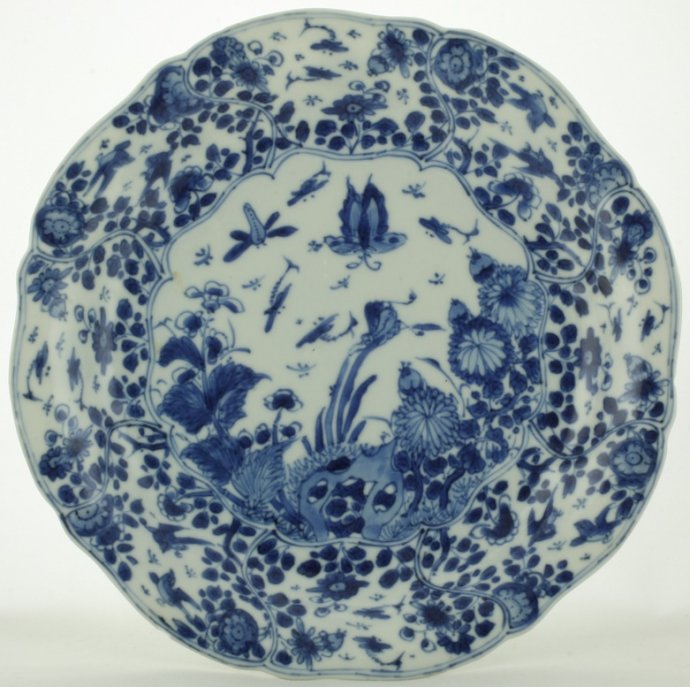
Sold Ceramics - Sold Blue and White Kangxi Period 1660-1722 - Dishes - Page 3
Object 2011147
Dish
China
c.1700
Height 28 mm (1.10 inch), diameter of rim 215 mm (8.47 inch), diameter of footring 120 mm (4.72 inch)
Moulded dish on footring with a curving spirally rim fluted in eight lobes. Decorated in underglaze blue with flowering plants growing from a taihu rock and various birds and insects in flight. The radiating panels are filled with two birds in flight amongst flowering plants alternating with insects in flight amongst flowering plants. On the reverse eight flower sprays. Marked on the base with the symbol mark: Flower, the symbol for purity in a double circle, underglaze blue.
For a similarly decorated dish, please see:
Condition: Three tiny fleabites a frit and three shallow chips to the rim.
References:
Lunsingh Scheurleer 1977, cat. 89
Price: Sold.

Sold Ceramics - Sold Blue and White Kangxi Period 1660-1722 - Dishes - Page 3
Object 2011560
Dish
China
c.1700
Height 37 mm (1.46 inch), diameter of rim 275 mm (10.83 inch), diameter of footring 141 mm (5.55 inch), weight 650 grams (22.93 ounce (oz.))
Large dish on footring, curving spirally sides and a fluted rim both with ten lobes. Decorated in underglaze blue with flying insects and flowering peony plants growing from pierced rockwork. The radiating moulded panels in the sides are filled with flowering plants. The radiating panels on the rim are decorated with flowering branches. On the reverse two large sprays of flowering branches. Marked on the base with a double circle, underglaze blue.
Ornamental taihu (garden) rocks with large, naturally formed holes were essential in Chinese gardens, which re-created nature in miniature. (Jörg 2002/2, p.110)
Condition: Some glaze rough spots, a chip and two frits to the rim. Some frits and chips to the footring.
Reference:
Price: Sold.
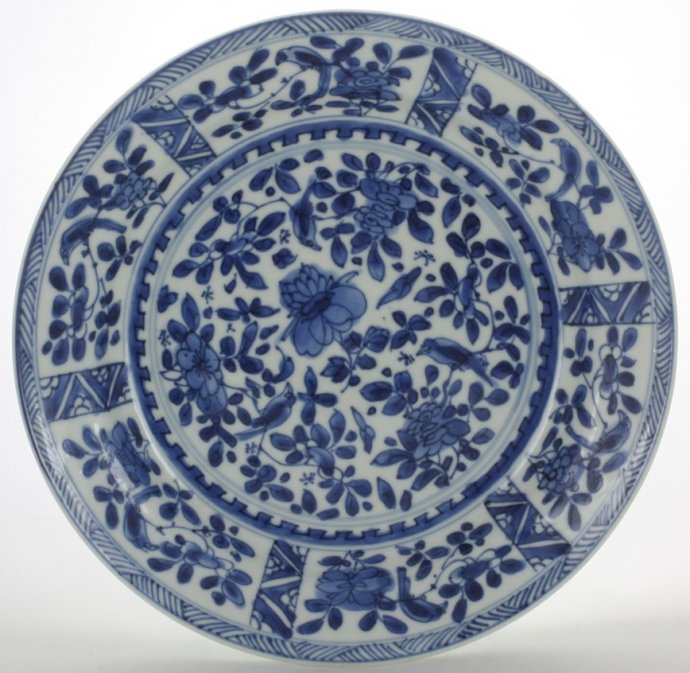
Sold Ceramics - Sold Blue and White Kangxi Period 1660-1722 - Dishes - Page 3
Object 2010462
Dish
China
1700-1720
Height 30 mm (1.18 inch), diameter of rim 215 mm (8.47 inch), diameter of footring 112 mm (4.41 inch)
Dish on footring with a flat rim. Decorated in underglaze blue with three birds perched on flowering branches. On the sides six panels each decorated with a bird perched on flowering branches. On the rim a zig-zag lines pattern border. On the reverse three flower sprays. Marked on the base with the symbol mark: Swastika in a lozenge, a Buddhist symbol and lucky sign in a double circle in underglaze blue.
Condition: Two chips, two tiny fleabites and a hairline to the rim.
Reference:
Price: Sold.


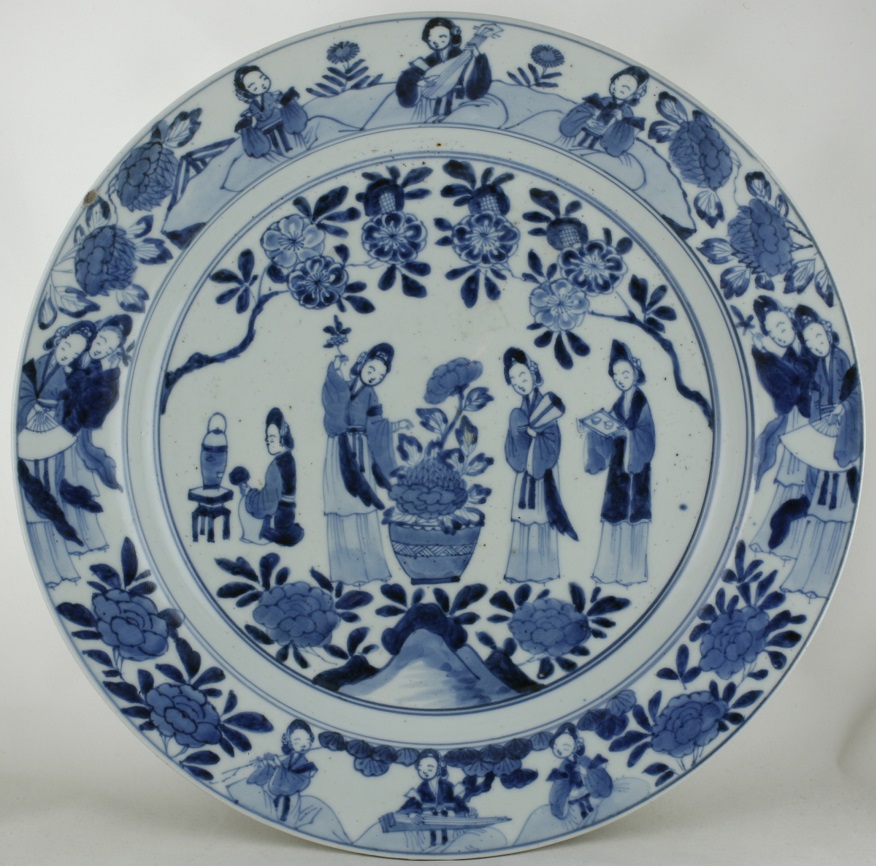
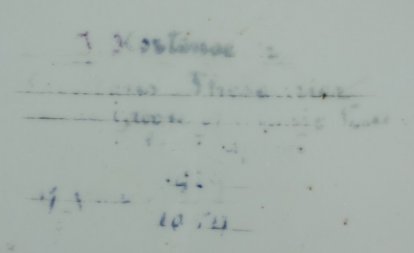
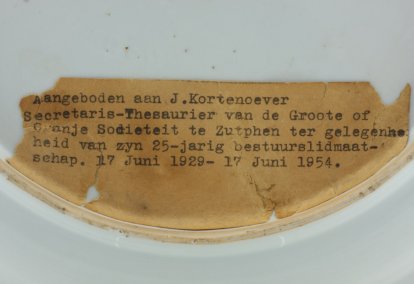
 create websites
create websites